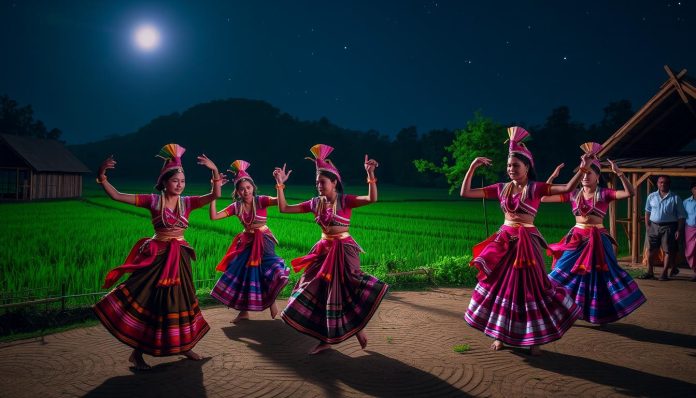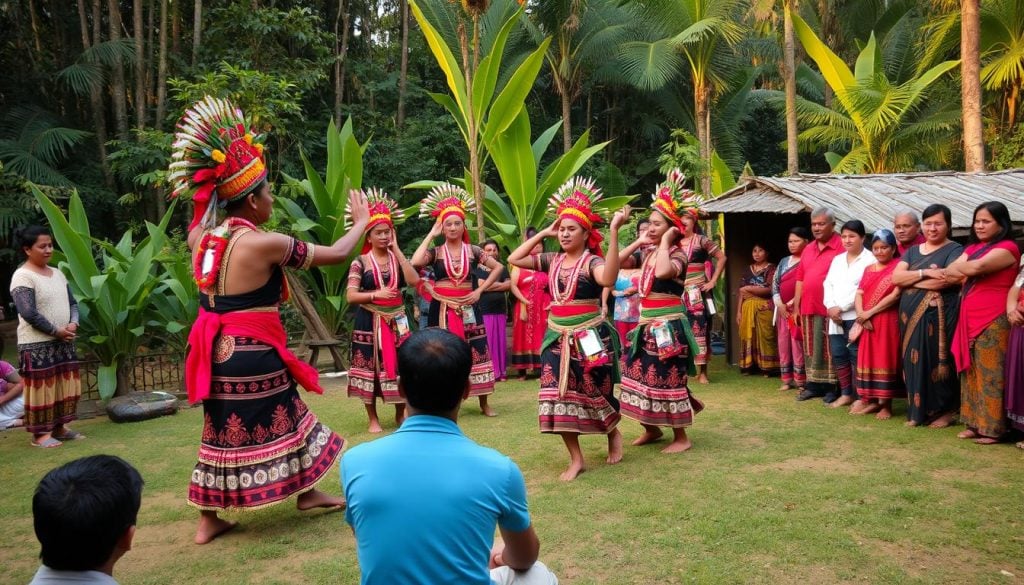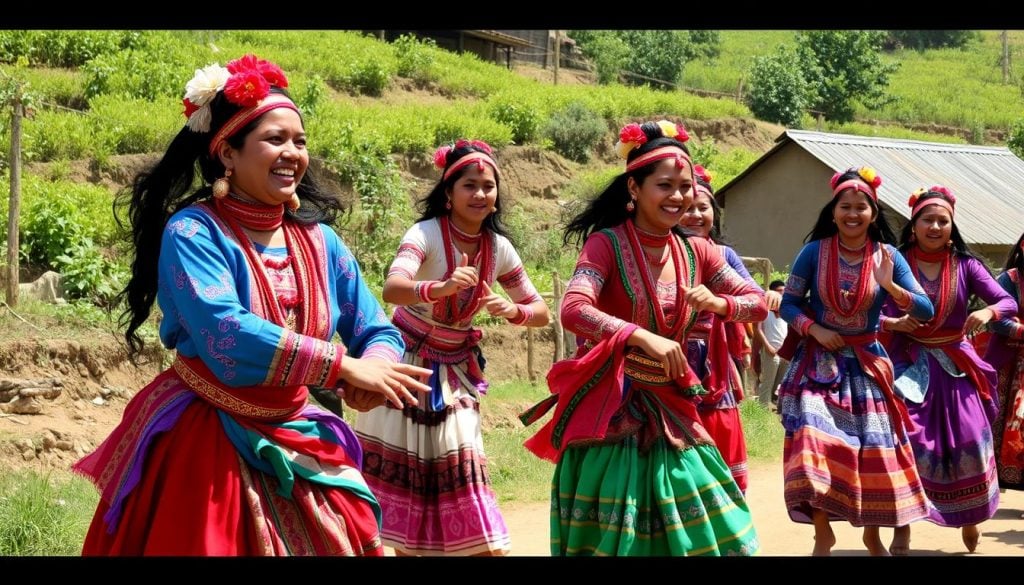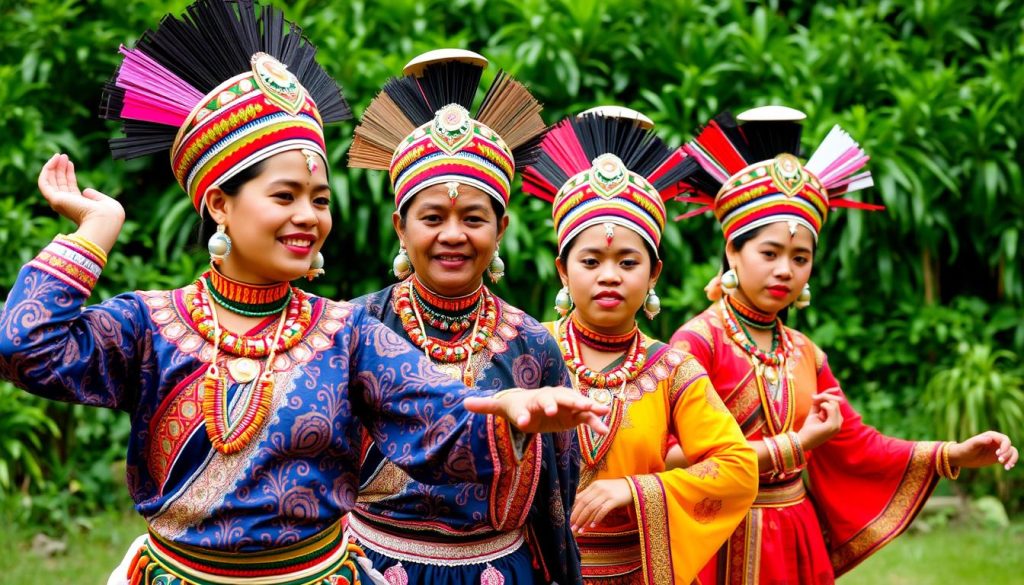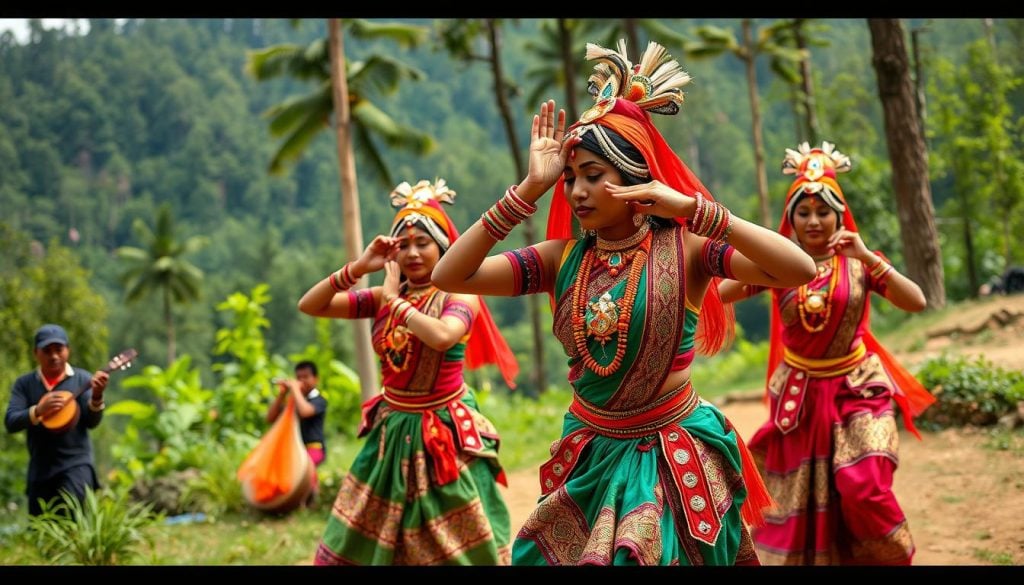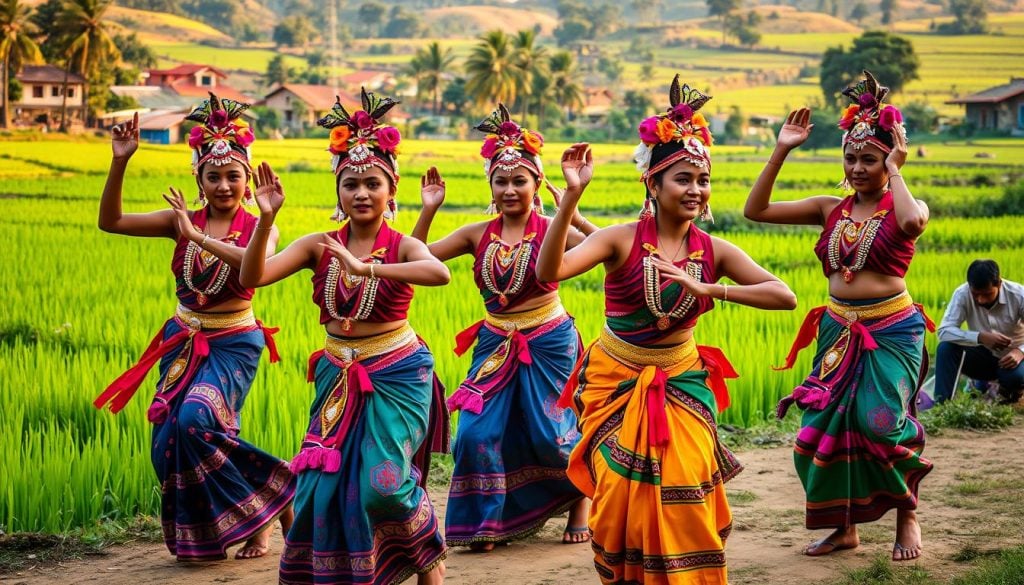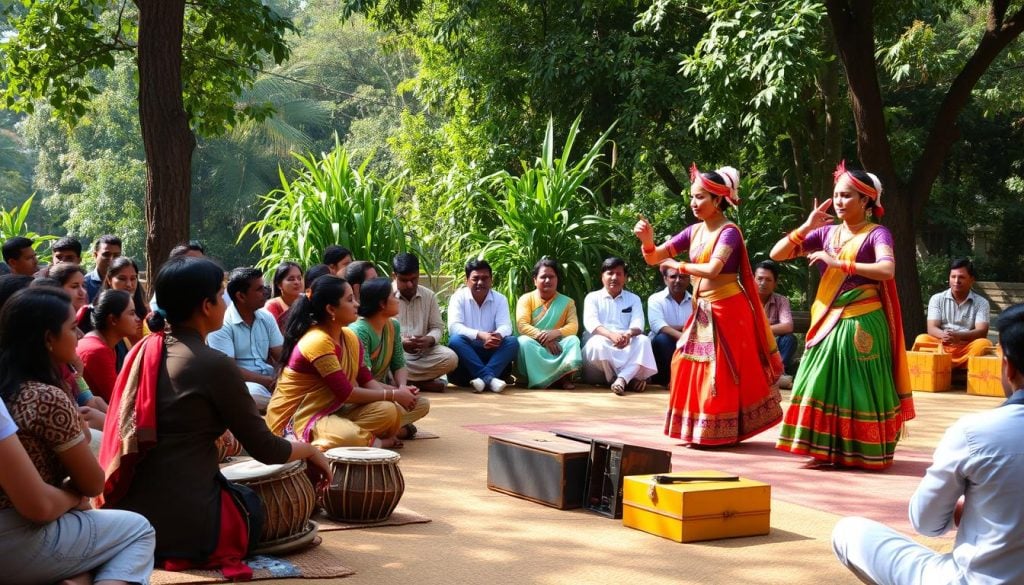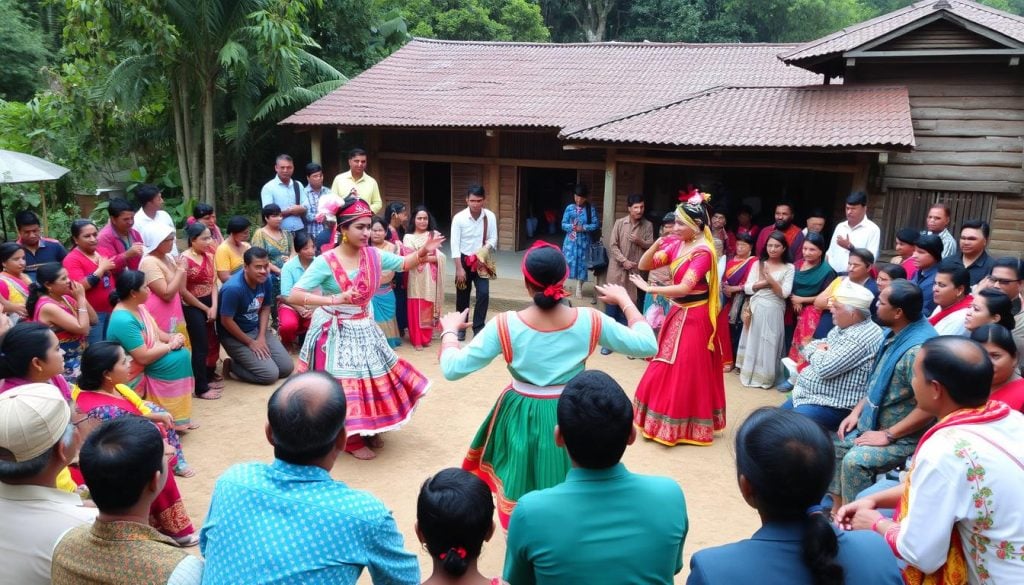Have you ever wondered how a dance can show a culture’s history and connect you to nature? Traditional Tharu dance performances let you dive into the vibrant traditions of the Tharu people in Nepal. These dances are not just art; they tell the Tharu way of life through rhythm and movement.
Exploring Tharu ethnic dance, you’ll see how these dances have been passed down for generations. Your journey to authentic Tharu dance experiences starts here. It reveals the beauty and importance of every step.
Introduction to Tharu Culture
The Tharu community lives mainly in the Terai region of Nepal. They have a vibrant and rich culture. Their traditions show their deep connection with nature, through farming and forestry.
Their culture is full of customs, languages, and art. These aspects make up the heart of Tharu culture.
Folklore is key in shaping Tharu values and norms. Stories from past generations tell of their struggles and successes. This keeps their heritage alive, showing who they are.
Tharu festivals and activities show their unique way of life. They celebrate nature and community. This gives us a peek into their enduring culture.
What is Traditional Tharu Dance Performances?
Traditional Tharu dance performances are lively shows of the Tharu community’s culture. They show the community’s daily life, celebrations, and heritage. These dances are a big part of their festivals and events, bringing joy to everyone.
Definition and Characteristics
The heart of Tharu folk dance is its energetic moves. These are matched with bright clothes and catchy tunes. Dancers perform alone or in groups, showing the importance of community.
The characteristics of Tharu dance include:
- Dynamic body movements that convey different emotions and narratives.
- Elaborate costumes, often handmade, reflecting local traditions and aesthetics.
- Use of traditional musical instruments, enhancing the overall performance experience.
Historical Background
The history of Tharu dance is closely tied to the community’s farming and social traditions. These dances started to celebrate harvests and religious events. Over years, they’ve taken on influences from other cultures, making them richer.
Today, traditional Tharu dance performances are a symbol of their cultural heritage. They keep their traditions alive while embracing new ideas.
Unique Features of Tharu Ethnic Dance
The Tharu ethnic dance is known for its lively rhythms and colorful costumes. It also features unique musical pieces. Understanding these elements helps us see the dance’s importance in the Tharu community.
Costumes and Attire
The costumes in Traditional Tharu dance show off the Tharu people’s rich culture. Women wear white sarees with bold patterns. Men have dhotis or traditional pants with embroidered shirts.
Each piece of Tharu dance attire is made for movement. This lets performers dance smoothly and gracefully.
Instruments Used in Tharu Dance
The musical instruments in Tharu dance set the mood for the show. Dhols, traditional drums, create lively beats. Flutes and harmoniums add melodies that make the performance special.
The instruments guide dancers through the rhythms of Traditional Tharu dance. This makes each show a captivating experience for the audience.
| Costume Type | Gender | Description |
|---|---|---|
| Saree | Female | White fabric with colorful patterns, symbolizing purity and vibrancy. |
| Dhotis | Male | Loose-fitting trousers, providing comfort and ease of movement during dance. |
| Embroidered Shirts | Male | Typically features intricate designs that highlight traditional craftsmanship. |
| Flutes | Instrument | Brings melodious elements to the dance, enhancing the overall harmony. |
| Dhols | Instrument | Drums that provide the rhythmic base, essential for guiding dancers. |
Popular Types of Tharu Tribal Dance Forms
The Tharu culture is full of vibrant dance forms. Each dance has its own special meaning and beauty. Danda Nach, Mayur Nach, and Ago Nach are among the most loved.
Danda Nach (Stick Dance)
Danda Nach is known for its rhythmic bamboo stick strikes. Dancers create a beautiful sight as they dance to the music. This dance shows the community’s spirit, performed at big festivals to celebrate unity and joy.
Mayur Nach (Peacock Dance)
The Mayur Nach, or Peacock Dance, is all about elegant movements like a peacock. Dancers wear colorful costumes that show the bird’s beauty. It celebrates the Tharu people’s bond with nature through dance.
Ago Nach (Fire Dance)
Ago Nach is a thrilling dance that shows the dancers’ bravery. They dance through fire, showing their connection to fire and its importance in Tharu culture. This dance is a powerful display of courage and heritage.
| Dance Name | Characteristics | Significance |
|---|---|---|
| Danda Nach | Rhythmic stick striking; synchronized movements | Symbolizes unity and community spirit |
| Mayur Nach | Graceful mimicry of peacock movements | Celebrates connection to nature |
| Ago Nach | Dancers weave through fire with torches | Represents courage and cultural heritage |
Experiencing Tharu Dance Performances in Nepal
For a unique cultural experience, people often look for Tharu dance venues in Nepal. These events let you dive into the vibrant traditions of the Tharu people. You get to see stories told through movement and music. Cultural shows in Nepal happen in many places, offering a deep dive into this rich heritage.
Venues for Cultural Shows
Tharu dance performances are often held in places like Sauraha, in the heart of the Chitwan district. Popular spots include:
- Outdoor courtyards
- Cultural centers
- Local community halls
These locations make your experience better, as you see how dance connects to Tharu culture stories. Each place has its own vibe, making the show even more enjoyable.
Best Times to Attend Performances
The best time to see Tharu dance is during festivals like Dashain and Tihar. The tourist season, from October to March, is also great for experiencing seasonal events in Tharu culture. Shows usually start at 6 PM and end at 8 PM, lasting about 45 minutes. It’s a memorable experience.
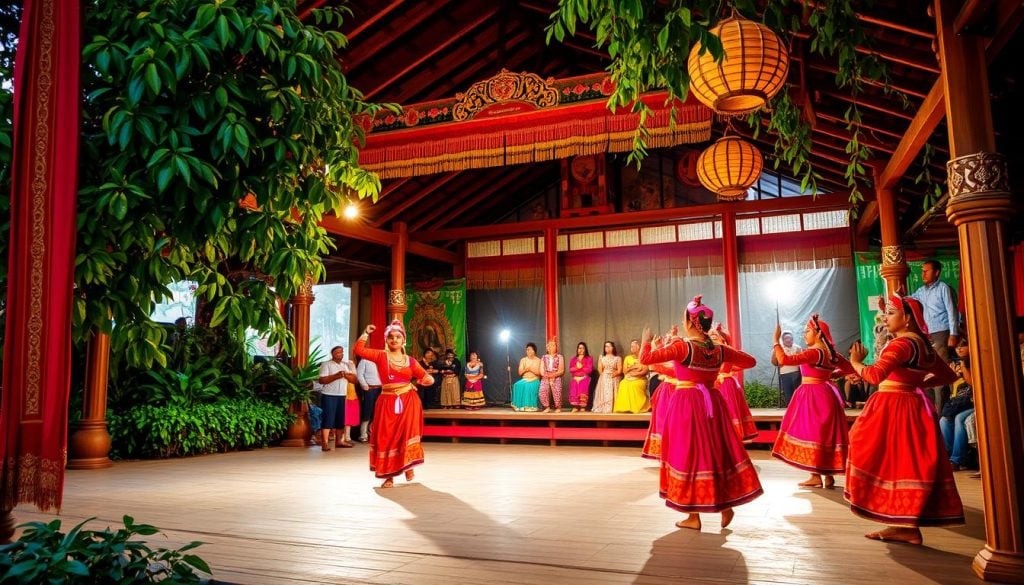
| Event | Date | Location | Duration |
|---|---|---|---|
| Dashain Festival | September – October | Chitwan | 45 minutes |
| Tihar Festival | October – November | Chitwan | 45 minutes |
| Tourist Season | October – March | Sauraha | 45 minutes |
Cultural Significance of Tharu Dance
The cultural significance of Tharu dance goes beyond just dancing. It shows the values and teachings of the Tharu people. These dances tell stories and pass down culture.
Connection to Nature and Community
Tharu dances show the bond between the community and nature. Dancers use rhythm and symbols to tell stories about the seasons and farming. This honors the Tharu’s respect for wildlife and the land, bringing everyone together.
Role in Festivals and Celebrations
Tharu dance is key in Tharu dance festivals and celebrations. These events celebrate important times like harvests and weddings. They bring joy and energy to the community, keeping traditions alive.
| Aspect | Details |
|---|---|
| Connection to Nature | Depicts seasonal changes and environmental respect |
| Community Engagement | Fosters unity and social bonds through shared experiences |
| Festivals | Integral to celebrations, marking important life events |
| Tradition Preservation | Passes down teachings and cultural practices to future generations |
Tharu Dance Performances: A Tourist Perspective
Attending Tharu dance performances is an exciting experience. It captivates your senses and lifts your spirits. The atmosphere is lively, filled with energy as performers show off their rich culture.
This experience lets you see traditional rituals and lively movements. Each performance is a unique event.
What to Expect During Performances
Tharu dance performances give you a peek into their culture. You’ll see colorful costumes and hear rhythmic music. Dancers bring stories and legends from the Tharu community to life.
Audience engagement is key in Tharu culture. Performers often invite you to join in. This makes the performance unforgettable.
Engaging with Performers
Talking to Tharu dancers makes your experience better. They love to connect with the audience. They might explain the dances’ significance or even teach you some moves.
This interaction deepens your appreciation and understanding. It makes your visit even more special.
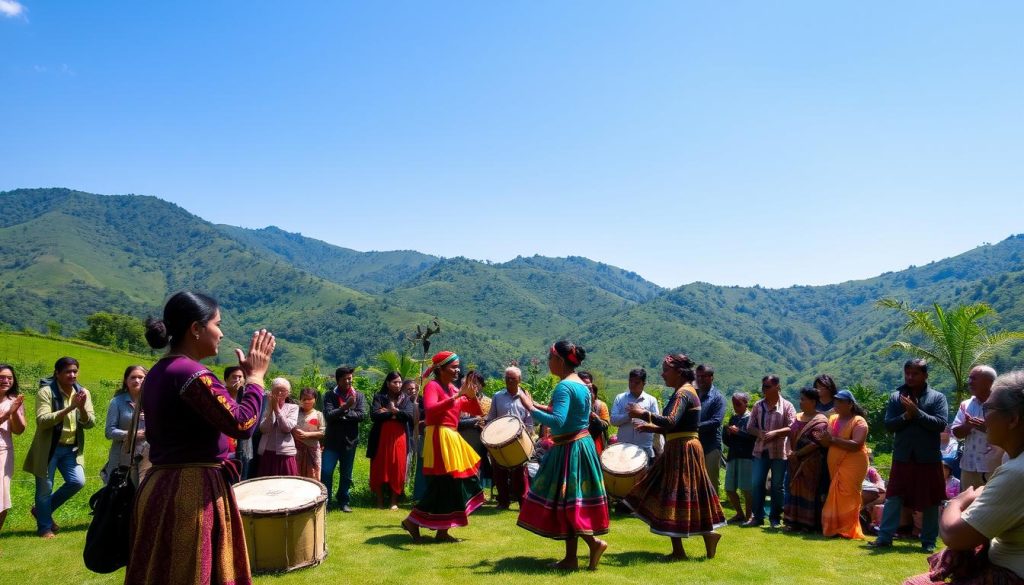
Authentic Tharu Dance Experiences in Sauraha
Sauraha village is on the edge of Chitwan National Park. It’s a place where you can really feel the Tharu culture. Here, you can see traditional Tharu dance and enjoy the beautiful scenery.
Overview of Sauraha Village
Sauraha village is known for its friendly people and natural beauty. It’s a great place to learn about Tharu culture. You can see their traditions come alive through dance and meet the locals.
Visiting the Tharu Village Museum
The Tharu Village Museum is a key part of your journey. It shows the history and traditions of the Tharu people. You’ll learn about the dances you might see and understand their importance.
Guidelines for Attending Tharu Dance Shows
Going to a Tharu dance show is a special chance to dive into a real cultural experience. Being well-prepared makes your time more enjoyable. It also shows respect to the performers and their traditions.
Booking Information
To book a Tharu dance show, contact your hotel or local tour operators. They usually sell Tharu dance show tickets at good prices. This makes it easy for both locals and visitors to join in.
Recommended Etiquette
Showing cultural respect is key for a great time. Here are some important tips:
- Only take photos if it’s okay with the performers.
- Don’t be disruptive during the show. It can ruin the experience for others.
- Be friendly with the performers and locals. It helps create a welcoming atmosphere.
By following these etiquette tips, you help make the event enjoyable for everyone.
| Aspect | Details |
|---|---|
| Booking Method | Hotel or Local Tour Operators |
| Ticket Price | Generally Affordable |
| Photo Policy | Ask Before Taking Photos |
| Behavior During Performance | No Disruptions |
| Interaction with Performers | Positive Engagement |
Impact of Tharu Dance on Local Communities
Tharu dance is key in shaping local communities. It acts as a way to express culture and bring people together. These lively dances show the deep Tharu dance and community impact they have. They help people unite and celebrate their heritage through vibrant movements and rhythms.
Tharu dance does more than entertain. It boosts cultural pride, especially among the young. This helps them connect with their roots. It’s important in a world where cultures are mixing more and more.
Tharu dance also helps the local economy. Cultural tourism brings in visitors who want to see these performances. This helps create jobs and funds local projects. It makes the community stronger for the future.
In short, Tharu dance is a cultural light and a force for community and economic growth.
| Impact Area | Details |
|---|---|
| Cultural Identity | Strengthens community ties and promotes pride in heritage |
| Social Interaction | Encourages gatherings and fosters relationships among community members |
| Economic Growth | Boosts tourism and creates jobs, leading to community development initiatives |
| Educational Opportunities | Teaches younger generations about their cultural roots and traditions |
| Community Cohesion | Brings people together through shared experiences and celebrations |
Preserving Tharu Culture Through Dance
Keeping Tharu culture alive through dance is crucial. It helps protect the identity and heritage of this special community. Local people are key in these efforts, thanks to cultural tourism and education.
Groups and government programs work with local artists. They make sure traditional Tharu dance is celebrated and taught.
Conservation Efforts
Protecting Tharu dance is vital for the culture. Local people join in cultural events to show off their dance. This draws tourists and boosts the local economy.
It also keeps the traditions alive. Artists and community members benefit from this.
Involvement of Younger Generations
Getting young people involved in Tharu culture is key. Schools and community groups run programs to teach them. This way, the next generation can carry on the traditions.
These programs help keep Tharu dance alive. They teach skills and share knowledge, ensuring the dance’s future.
| Aspect | Details |
|---|---|
| Conservation Efforts | Community engagement in cultural tourism and educational programs. |
| Youth Involvement | Encouragement of traditional performances through school and community programs. |
| Future of Tharu Dance | Ensuring the continuation of dance forms through active participation of the youth. |
Conclusion
Watching traditional Tharu dance is more than a show. It’s a chance to truly connect with Tharu culture. Each step and beat shares a story, linking you to the land and the Tharu people’s heritage.
By joining in these lively dances, you help keep this history alive. These performances celebrate community, nature, and the joy of festivals.
Your attendance at these dances does more than entertain. It helps preserve Nepal’s unique Tharu culture. These traditions educate and spark interest in old practices.
In short, experiencing Tharu dance makes you part of a rich story. It’s about shared experiences and community ties. Support these dances and you’ll gain from the Tharu community’s vibrant legacy.

































